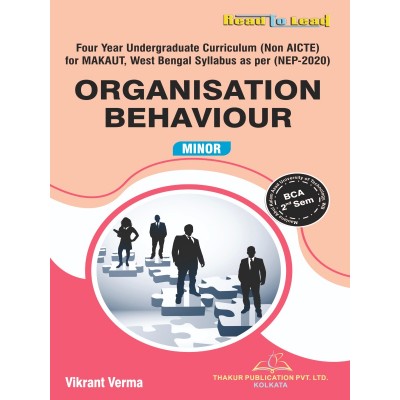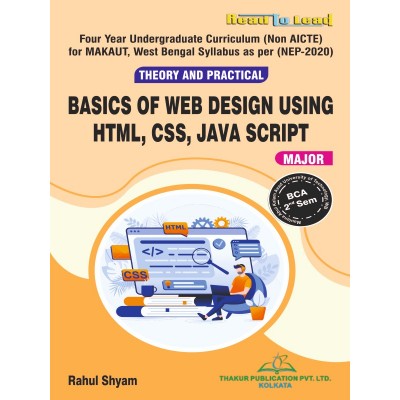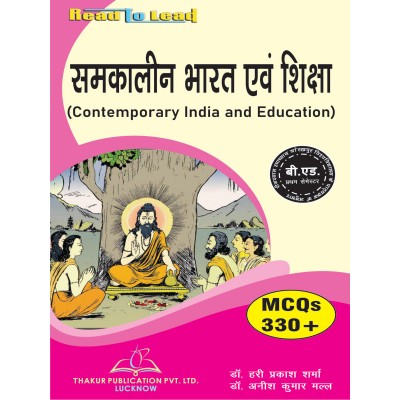Categories
- Pharmacy
-
Nursing
-
MBA
-
BBA
- U.P. State University
- Veer Bahadur Singh Purvanchal University, Jaunpur
- Chaudhary Charan Singh University, Meerut
- Dr. Bhimrao Ambedkar University, Agra
- Chhatrapati Shahu Ji Maharaj University, Kanpur
- Mahatma Jyotiba Phule Rohilkhand University, Bareilly
- Mahatma Gandhi Kashi Vidyapith, Varanasi
- Dr. Ram Manohar Lohia Avadh University, Ayodhya
- Deen Dayal Upadhyaya Gorakhpur University
- Prof. Rajendra Singh (Rajju Bhaiya) University, Prayagraj
-
BCA
- UP State Universities
- University of Pune
- I.K.Gujral Punjab Technical University (PTU)
- University of Rajasthan
- Rashtrasant Tukadoji Maharaj Nagpur University
- Uttar Pradesh NEP2020
- University of Rajasthan ,Jaipur (According to NEP-2020)
- BCCA (B. Com - Computer Science)
- Haryana
- West Bengal
- BBA (CA)
- PUNE BCA (Sci,Commerce)/B.Com (CA)
- Dr. A. P. J. Abdul Kalam Technical University, Lucknow ( AKTU )
- MCA
-
B Ed
- Lucknow University B.Ed Books
- Chaudhary Charan Singh University/Maa Shakambhari University, Saharanpur
- Dr Bhim Rao Ambedkar University, Agra
- Mahatma Gandhi Kashi Vidyapeeth, Varanasi
- Chhatrapati Shahu Ji Maharaj University
- Prof. Rajendra Singh (Rajju Bhaiya) University, Prayagraj (PRSU)
- Mahatma Jyotiba Phule Rohilkhand University(Mjpru), Bareilly
- Dr. Ram Manohar Lohia Avadh University, Ayodhya
- Bundelkhand University, Jhansi
- B.A,B.ed
- B.Sc, B.ed
- Deen Dayal Upadhyaya Gorakhpur University
- Veer Bahadur Purvanchal University (VBPU)
- Maharaja Suhel Dev State University ,Azamgarh (MSDSU)
- Raja Mahendra Pratap Singh State University, Aligarh (RMPSSU)
- Barkatullah Vishwavidyalaya (Bhopal)
- Jiwaji University (Gwalior)
- Vikram University (Ujjain)
- Dr. Harisingh Gour University (Sagar)
- Devi Ahilya Vishwavidyalaya (Indore)
- Rani Durgavati Vishwavidyalaya (Jabalpur)
- Awadhesh Pratap Singh University (Rewa)
- Maharaja Chhatrasal Bundelkhand University (Chhatarpur)
- D. EL. ED
- TET
-
B Com
-
B Sc
- B.Sc. U.P. State Universities Common Syllabus NEP
- Veer Bahadur Singh Purvanchal University, Jaunpur
- University of Lucknow
- Chaudhary Charan Singh University, Meerut
- Madhya Pradesh
- Chhatrapati Shahu Ji Maharaj University, Kanpur
- Dr. Bhimrao Ambedkar University, Agra
- Mahatma Gandhi Kashi Vidyapith, Varanasi
- DEEN DAYAL UPADHYAYA GORAKHPUR UNIVERSITY
- Prof. Rajendra Singh (Rajju Bhaiya) University, Prayagraj
- Dr. Ram Manohar Lohia Avadh University, Ayodhya
- Mahatma Jyotiba Phule Rohilkhand University, Bareilly
- Uttarakhand State Universities
- B.Sc. Bihar Universities Common Syllabus NEP
- University of Rajasthan (Jaipur)
- Haryana
-
Bachelor of Arts [B.A.]
- B.A. Of U.P. State Universities Common Syllabus NEP
- Veer Bahadur Singh Purvanchal University, Jaunpur
- University of Lucknow
- Chaudhary Charan Singh University, Meerut
- Chhatrapati Shahu Ji Maharaj University, Kanpur
- Dr. Bhimrao Ambedkar University, Agra
- Mahatma Gandhi Kashi Vidyapith, Varanasi
- Deen Dayal Upadhyaya Gorakhpur University
- Prof. Rajendra Singh (Rajju Bhaiya) University, Prayagraj
- Dr. Ram Manohar Lohia Avadh University, Ayodhya
- Mahatma Jyotiba Phule Rohilkhand University, Bareilly
- Madhya Pradesh
- Uttarakhand
- Bihar
- University of Rajasthan (Jaipur Syllabus as Per NEP2020)
- Haryana NEP-2020
- B Tech
- LLB
- SWA Education
ORGANISATION BEHAVIOUR MAKAUT BCA SECOND SEM

AUTHORS: Mr. Vikrant Verma
ISBN : 978-93-5755-672-9
Tax excluded
Contents
|
Unit 1: Introduction to Organisational Behaviour |
||
|
1.1. |
Organisational Behaviour (OB) |
13 |
|
1.1.1. |
Meaning and Definition of Organisational Behaviour |
13 |
|
1.1.2. |
Nature/ Characteristics of Organisational Behaviour |
14 |
|
1.1.3. |
Scope of Organisational Behaviour |
14 |
|
1.1.4. |
Historical Development of Organisational Behaviour |
16 |
|
1.1.4.1. |
Industrial Revolution |
17 |
|
1.1.4.2. |
Scientific Management |
17 |
|
1.1.4.3. |
Human Relations Movements |
18 |
|
1.1.4.4. |
Organisational Behaviour |
20 |
|
1.1.5. |
Why Study Organisational Behaviour? |
21 |
|
1.1.6. |
Importance of Studying Organisational Behaviour |
22 |
|
1.1.7. |
Foundations of Organisational Behaviour |
24 |
|
1.1.8. |
Determinants of OB |
25 |
|
1.1.9. |
Levels of OB |
26 |
|
1.1.10. |
Models of OB |
27 |
|
1.1.11. |
Organisational Behaviour Processes |
30 |
|
1.1.12. |
Challenges and Opportunities in the Development of OB |
32 |
|
1.1.13. |
Disciplines Contributing to OB |
34 |
|
1.1.14. |
Limitations of OB |
35 |
|
1.2. |
Individual Behaviour in Organisations |
37 |
|
1.2.1. |
Concept of Individual Behaviour |
37 |
|
1.2.2. |
Nature of Individual Behaviour |
38 |
|
1.2.3. |
Need of Understanding Individual Behaviour |
38 |
|
1.2.4. |
Foundation of Individual Behaviour |
39 |
|
1.3. |
Exercise |
42 |
|
|
|
|
|
Unit 2: Individual Behaviour |
||
|
2.1. |
Personality |
43 |
|
2.1.1. |
Meaning and Definition of Personality |
43 |
|
2.1.2. |
Nature of Personality |
43 |
|
2.1.3. |
Types of Personality |
45 |
|
2.1.4. |
Major Personality Attributes Influencing Organisational Behaviour |
45 |
|
2.1.5. |
Determinants of Personality |
48 |
|
2.1.6. |
Significance of Personality |
51 |
|
2.2. |
Theories of Personality |
51 |
|
2.2.1. |
Personality Traits Theory |
52 |
|
2.2.1.1. |
Hans Eysenck’s Three Trait Theory |
52 |
|
2.2.1.2. |
Big Five Model |
53 |
|
2.2.1.3. |
Allport’s Trait Theory |
55 |
|
2.2.1.4. |
R.B. Cattell Theory |
55 |
|
2.2.2. |
Personality Type Theory |
56 |
|
2.2.2.1. |
Myers Briggs Type Indicator (MBTI) |
57 |
|
2.2.2.2. |
Sheldon’s Type Theory |
58 |
|
2.2.2.3. |
Spranger’s Value Theory |
59 |
|
2.2.3. |
Psychodynamic Theory |
59 |
|
2.2.3.1. |
Sigmund Freud’s Psychosexual Theory |
59 |
|
2.2.3.2. |
Erik Erikson’s Theory |
61 |
|
2.3. |
Perception |
62 |
|
2.3.1. |
Introduction |
62 |
|
2.3.2. |
Nature of Perception |
63 |
|
2.3.3. |
Components of Perception |
63 |
|
2.3.4. |
Factors Influencing Perception |
65 |
|
2.3.5. |
Perceptual Process |
66 |
|
2.3.6. |
Principles of Perception |
69 |
|
2.3.7. |
Errors in Perception/ Perceptual Errors |
70 |
|
2.3.8. |
Importance of Perception |
72 |
|
2.3.9. |
Difference between Perception and Attitude |
73 |
|
2.4. |
Attributions |
73 |
|
2.4.1. |
Meaning and Definition of Attribution |
73 |
|
2.4.2. |
Types of Attribution |
74 |
|
2.4.3. |
Attribution Theory |
74 |
|
2.4.4. |
Attribution Errors/Bias |
76 |
|
2.5. |
Attitudes |
77 |
|
2.5.1. |
Meaning and Definition of Attitudes |
77 |
|
2.5.2. |
Characteristics of Attitudes |
78 |
|
2.5.3. |
Importance of Attitudes |
79 |
|
2.5.4. |
Sources of Attitude |
79 |
|
2.5.5. |
Effects of Employee Attitude |
80 |
|
2.5.6. |
Attitude Formation |
81 |
|
2.5.6.1. |
Process of Attitude Formation |
81 |
|
2.5.6.2. |
Factors Influencing Attitude Formation |
82 |
|
2.5.7. |
Changing Attitude |
83 |
|
2.5.7.1. |
Theories of Attitude Formation and Attitude Change |
83 |
|
2.5.7.2. |
Barriers to Changing Attitude |
84 |
|
2.5.7.3. |
Overcoming Barriers to Changing Attitude |
85 |
|
2.6. |
Learning |
86 |
|
2.6.1. |
Meaning and Definition of Learning |
86 |
|
2.6.2. |
Characteristics of Learning |
87 |
|
2.6.3. |
Learning Process |
87 |
|
2.6.4. |
Principles of Learning |
89 |
|
2.6.5. |
Significance of Learning |
90 |
|
2.7. |
Learning Theories |
91 |
|
2.7.1. |
Classical Conditioning Theory |
91 |
|
2.7.2. |
Operant/Instrument Conditioning Theory |
92 |
|
2.7.3. |
Social Learning Theory |
93 |
|
2.7.3.1. |
Modelling Theory |
93 |
|
2.7.3.2. |
Social Cognition Theory |
94 |
|
2.7.4. |
Cognitive Learning Theory |
95 |
|
2.8. |
Job Satisfaction |
95 |
|
2.8.1. |
Meaning and Definition of Job Satisfaction |
95 |
|
2.8.2. |
Nature of Job Satisfaction |
96 |
|
2.8.3. |
Factors Affecting Job Satisfaction |
97 |
|
2.8.4. |
Significance of Job Satisfaction |
98 |
|
2.9. |
Exercise |
99 |
|
|
|
|
|
Unit 3: Group and Team Dynamics |
||
|
3.1. |
Group |
100 |
|
3.1.1. |
Meaning & Definition of Group |
100 |
|
3.1.2. |
Nature of Group |
100 |
|
3.1.3. |
Why do People Join Groups |
101 |
|
3.1.4. |
Types of Groups in Organisations |
102 |
|
3.1.5. |
MAKAUT2024/BCA/2/03
46 Items
New
2 other products in the same category:
Comments (0)
No customer reviews for the moment.
Your review appreciation cannot be sent Report comment
Are you sure that you want to report this comment?
Report sent
Your report has been submitted and will be considered by a moderator.
Your report cannot be sent Write your review Review sent
Your comment has been submitted and will be available once approved by a moderator.
Your review cannot be sent Viewed productsCustomers who bought this product also bought: | |













